Driving your semi in treacherous conditions during the winter, when there’s ice and/or snow on the road, can be dangerous. This is where tire chains can come in handy. By simply putting these chains onto your truck’s tires when you know you’ll be driving on slippery roads, you can get more traction to better maintain control.
Keep in mind that tire chains are meant to be used only when you’re required to drive through winter weather conditions, so they shouldn’t be left on your tires once you don’t need them anymore. When roadways are dry, and there’s no more risk of slipping, it’s time to take the chains off.
Here’s a Short Guide to Putting Tire Chains on Your SemiIn a few easy steps, you can have your chains on your tires. Here’s a basic guide to help you get started:

Side note: What tires do you chain on a semi truck? The drive wheels.
Always Drive Safely, Even with Tire Chains!Now that you have a better idea of how to put on tire chains on a semi, you can take this extra step to stay safe on the road during the harsh winter season. Just remember, you’ll need to reduce your speed (typically, max speeds are around 30 mph) while you’re driving with chains on your tires to ensure your own safety, as well as the safety of other drivers. And it’s also important to be aware of any local requirements regarding when to use tire chains so you can follow the law.
Once you get the hang of things, you’ll be able to efficiently put tire chains on your tires, as well as take them off, without spending too much time getting it all done.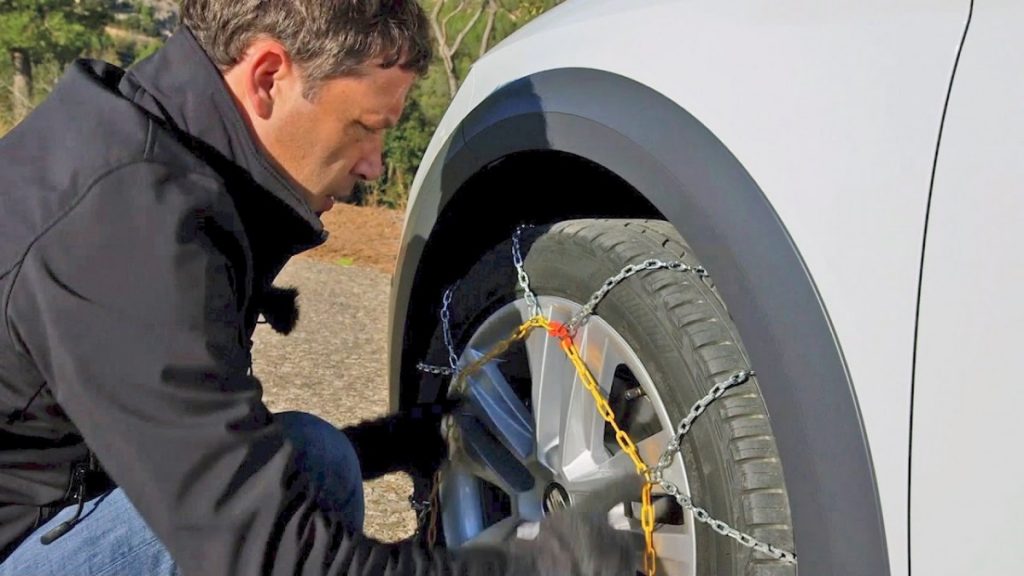
Sources:
https://www.revinsurance.com/importance-tire-chains-for-semi-trucks/
https://itstillruns.com/how-to-install-semi-truck-tire-chains-13370082.html
https://schneiderjobs.com/blog/how-to-put-tire-chains-on-semi
https://www.youtube.com/watch?v=TWmm2I5XypA
https://www.youtube.com/watch?v=_RqpU8Rlwv8
https://www.tirechain.com/Snow-Chains-Truck-Installation.htm
Updated on November 18, 2020
This entry was posted on Tuesday, February 25th, 2020 at 1:00 pm and is filed under Uncategorized. You can follow any responses to this entry through the RSS 2.0 feed. Both comments and pings are currently closed.
Winter weather and slick, snowy surfaces don’t exactly mesh well with big-rig trucks. Thankfully, as a driver, you can install snow chains on your tires to give you much-needed stability and grip on slick roads.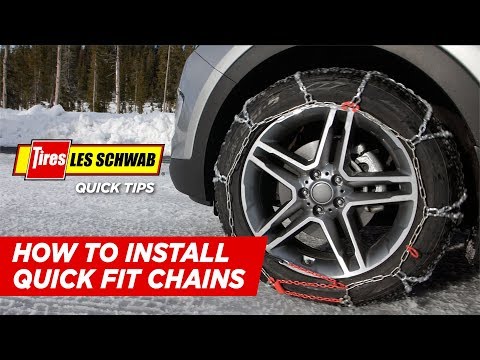 Read on for more information:
Read on for more information:
Of course, every truck is slightly different as are chains. Therefore, you might have to alter some steps to your individual needs. Here’s how to go about putting chains on your semi:

Obviously, chains are not necessary except in wintery conditions where the roads are covered in ice and snow. In fact, putting chains on your truck if there are no such conditions can actually cause harm to your truck. Keep in mind, on some mountain roads, there are chain laws, requiring all trucks to have chains installed before they can proceed. Finally, you can install chains when your truck is stuck to help cut through the precipitation.
The name of the game when driving with chains on your tires is to drive slow. Most trucks won’t go over 30 mph with chains. It’s also important that you allow for the added weight of the chains. If your truck takes up to six chains, this can mean adding around 1,000 pounds to your vehicle weight. Some people prefer snow socks as an alternative to chains for this reason as they are much lighter. However, snow socks don’t meet the chain mandates that are set for some mountainous roads.
Some people prefer snow socks as an alternative to chains for this reason as they are much lighter. However, snow socks don’t meet the chain mandates that are set for some mountainous roads.
There are a few types of chains to choose from for truck tires. They are outlined below:
Once you hit dry or wet pavement that isn’t coated in snow, it’s time to remove your tire chains. Pull over to a safe location out of the way of traffic and begin removing your chains. Once you have them removed, store them again in your truck for the next time you will need to employ them to get you safely from point A to point B.
Dealing with snow chains is most certainly not the most glamorous or fun aspect of being a truck driver. However, if you frequent mountainous areas or locations that tend to experience heavy snowfall, it’s important to have this skill at the ready and have chains on hand to keep you from getting stuck or sliding all over the road.
Interested in driving for Knight Transportation? View Trucking Jobs
You may also enjoy What To Do If You Start Having Truck Brake Issues
Category: Interesting news.
The truck tire industry is developing rapidly. Designers improve the rubber compound, improve the tread pattern - and still, in winter it is impossible to do without such an old-fashioned accessory as snow chains . Consider why the driver needs chains and how to install them correctly.
Snow chains are used off-road, in ice and to improve the grip of wheels with the road.
Due to the fact that the pattern of the chain protrudes outward and the contact area of the chains with the road is smaller than that of the wheel, there are gaps between the chain and the tire, the vehicle's flotation is improved, and wheel slip is prevented.
The main purpose for which truck drivers put chains on their wheels - is to ensure a confident ride on slippery roads and in snowdrifts, to increase the stability and controllability of the car due to better grip. nine0005
 nine0024
nine0024 Experienced drivers always carry chains on their wheels. They rescue not only on the ice, but also help out at the cargo terminal if the snow is falling faster than it is removed by public utilities.
The variety of types allows you to find an option for any task - for certain types of trucks, for example, MAN and Scania, chains can be of different “caliber”, and their pattern is made in the form of “honeycombs”, “ladders”, etc. - depending on the type of road surface.
For heavy trucks and trucks, studded chains are mainly used to ensure tire grip in the most difficult areas. nine0005
In Europe and Scandinavia, road sections where chains must be used are marked with special signs. Not far from dangerous areas - sites for installing chains.
The requirements for installing chains in different countries are different: somewhere it is enough to “arm” only the drive axle, somewhere you need to put chains on all the wheels of the tractor and even on the wheels of the semi-trailer. Before you travel in winter, check the chain requirements for your itinerary. nine0005
Before you travel in winter, check the chain requirements for your itinerary. nine0005
Before leaving for flight , it is important to check the condition of chains and store them in special cases or strong plastic bags. Worn out chains break in transit and can shatter headlights and fender liner, damage the fuel tank and cargo, get stuck between the wheels and cause an accident.
The chains must fit the wheel size of your truck. The specifics of its installation, the type of fastening and the degree of tension depend on the type of chain.
Do not accelerate and brake sharply when driving with chains on wheels, exceed the recommended speed: 50 km/h for metal chains and 80 km/h for soft chains (rubber, plastic). As the speed increases, centrifugal force can cause the chains to loosen, causing the chain to vibrate and contact the fender liner.
Immediately after the pavement has been replaced with clean asphalt, the chains must be removed - otherwise they will wear out quickly. After removal, the chain must be cleaned and dried.
After removal, the chain must be cleaned and dried.
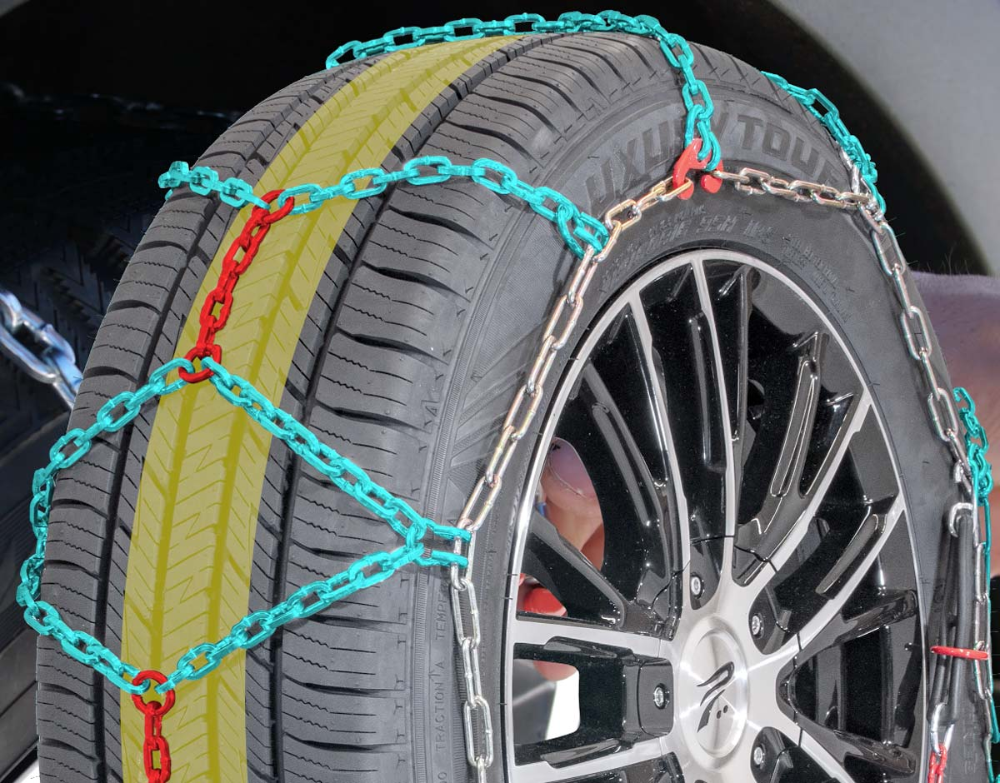
high -quality used spare parts for SCANIA trucks can be found in our catalog
Search for used
90,000 traffic on slippery roadfor heavy vehicles (especially in tractors) on slippery road problems occur faster than cars. We can mention two circumstances that make it difficult for heavy vehicles to drive on slippery roads:
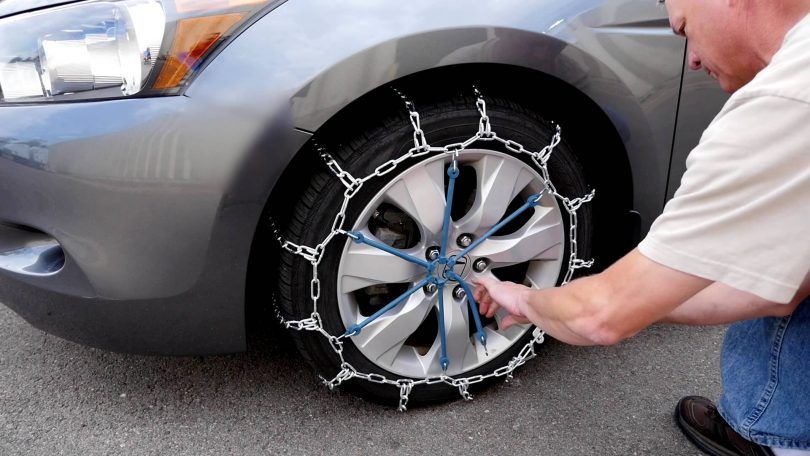
Large vehicles passing other vehicles often have to move close to the edge of the road. In order to maintain a correct and stable course in such cases, it is important to drive at the appropriate speed, have good tires and brakes.
Due to curves and steep climbs, you are constantly forced to choose the right speed and place on the road so that other road users feel safe. The vehicle should always be driven according to the road traction in each particular location. nine0005
Semi-trailer slip
When driving a road train, the semi-trailer is the most dangerous situation, and it is because of it that driving on slippery roads becomes especially difficult.
An experienced professional driver will immediately notice that the car is slipping. Semi-trailer sliding is not so easy to notice, but after a while, looking in the rear-view mirror, you will see that the semi-trailer is going sideways. Therefore, it is important to look in the rear-view mirror every time you brake on a slippery road.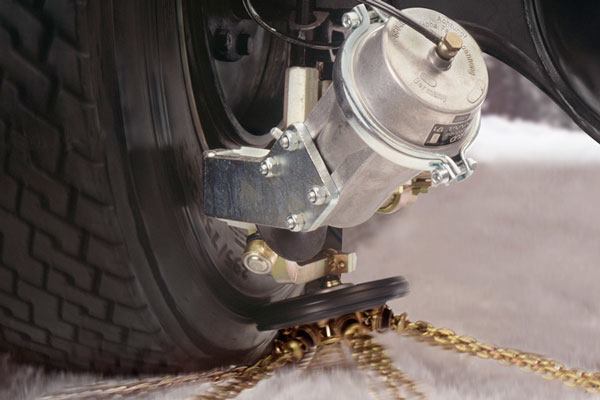 nine0005
nine0005
When a long and heavy vehicle begins to slip, a serious situation is created that requires great attention. It is very difficult to control the vehicle again. This can take a lot of time and space on the road. Remember that it is better to drive a road train into a ditch than to collide with vehicles moving in the oncoming lane.
The semi-trailer slips especially due to the following reasons:
Incorrect vehicle-semi-trailer brake alignment, improper load stowage and uneven road surfaces can all cause both vehicle and semi-trailer to slip. nine0005
When driving a tractor with a semi-trailer, it is very important to ensure that the semi-trailer moves well in the saddle and does not interfere with the turning of the tractor (which requires regular lubrication of the saddle).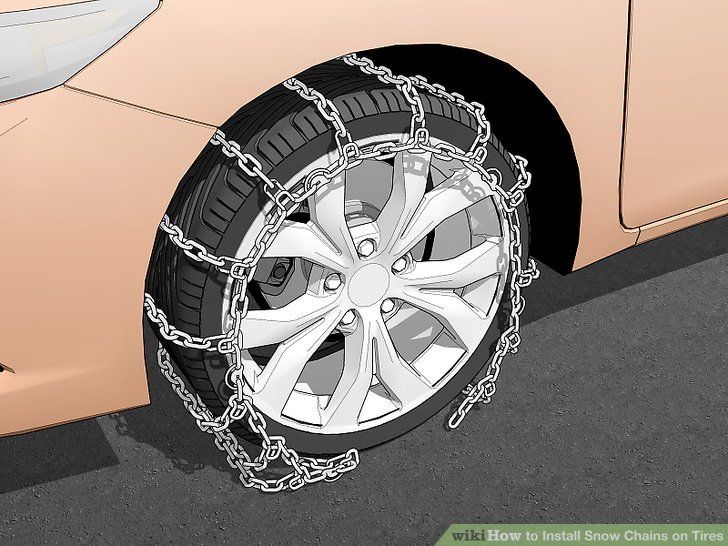 In order to be safe driving on a slippery road on a tractor, it is necessary to foresee possible situations on the road in advance, correctly assess the traffic conditions and the condition of the road. It is also important that the vehicle is technically sound. Serious trailer slip accidents are usually caused by the trailer sliding into oncoming traffic. The driver of the road train shown in the photograph finds himself in a difficult position, as the trailer slides into oncoming traffic. This situation may end in a serious collision (see fig. 1). nine0005
In order to be safe driving on a slippery road on a tractor, it is necessary to foresee possible situations on the road in advance, correctly assess the traffic conditions and the condition of the road. It is also important that the vehicle is technically sound. Serious trailer slip accidents are usually caused by the trailer sliding into oncoming traffic. The driver of the road train shown in the photograph finds himself in a difficult position, as the trailer slides into oncoming traffic. This situation may end in a serious collision (see fig. 1). nine0005
Slippery road when descending a slope
When descending a long slope, the slope may not be more slippery in winter.
Therefore, before driving down a slope, you should:
If you are using chains, consider where the load is placed.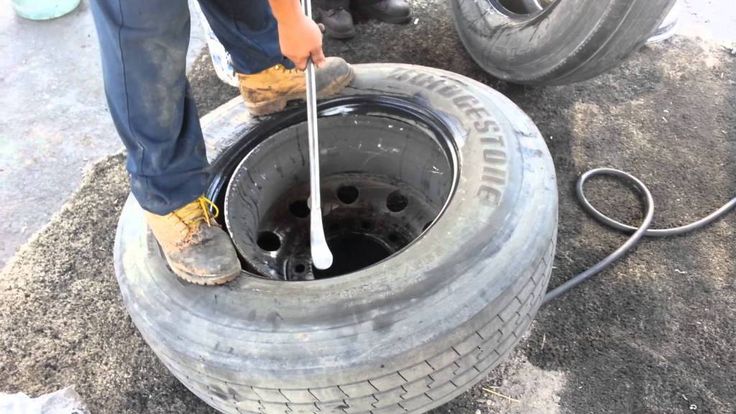
Due to the heavy load stowed at the front and the powerful auxiliary brakes that only stop the drive wheels, these wheels can begin to slip. To prevent this from happening, you can put chains on the drive wheels (see Fig. 2).
If the load is placed at the end, the front wheels may slip and the vehicle may not be steered. In order to avoid this, in some cases it is required to put chains on the right front wheel. This is especially characteristic of tractors with a semi-trailer and a two-axle axle. nine0005
Lifting the tandem axle by the drive axle makes it difficult to drive on a slippery road (see fig. 3)
If you are driving on a slippery road, most of the load should be placed in the motor vehicle, as this will help reduce the risk of the road train starting to slip , and the so-called "scissors" are formed, in addition, the vehicle in this case will slide less.
It is sometimes necessary to put chains on the trailer wheels to avoid the trailer from slipping and to provide sufficient stability and braking when going downhill (see fig.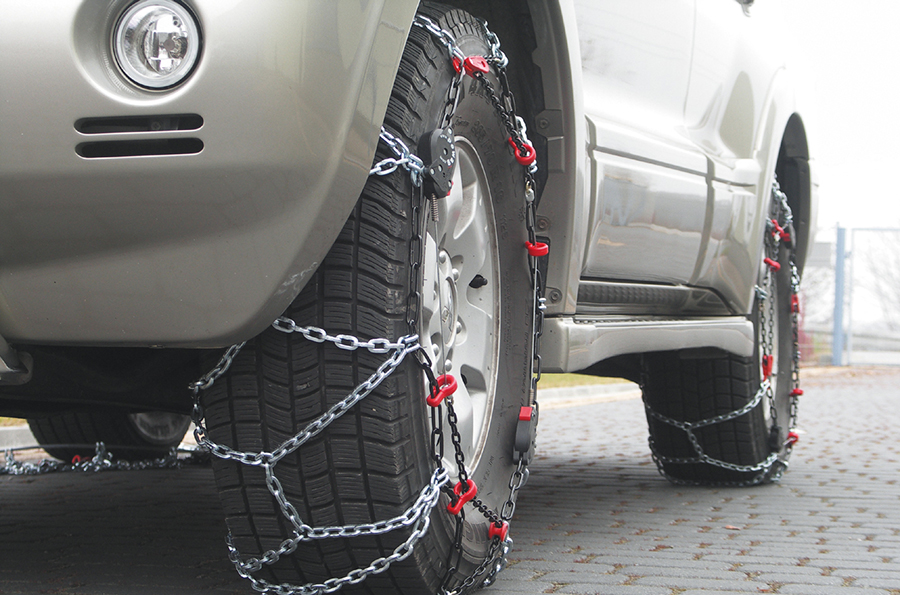 4). nine0005
4). nine0005
When driving on slippery roads, the service brake system gives a better braking effect than the auxiliary brake system, since the auxiliary brake system brakes only the driven wheels. Always be aware of the dangers that can arise if the brakes overheat or stop working. If you are using chains when driving downhill, pay attention to load distribution to improve traction.
IMPORTANT! Do not go up or down the slope if you see that another stuck vehicle is already standing there.
The safety of descending a mountain depends on how prepared you are BEFORE starting the descent. The road can be so slippery that it is best not to start moving until it is paved.
Only a low starting speed and proper use of auxiliary brakes and gears will help keep the brakes from overheating and failing. nine0005
How to install universal snow chains
Please note: there are different types of snow chains!
1. Place snow chains on the ground. Make sure there are no knots or tangles.
Place snow chains on the ground. Make sure there are no knots or tangles.
2. Position the snow chains on the wheel so that the locks on the top side of the chain are in the "free" position. Fasten the side of the lock under the rib of the outer wheel and push back about ¼ turn of the wheel. nine0005
3. First attach the top side chain.
4. Then place the chain by hand on the wheel surface while tightening the outer side chain. Then fasten the lock of the outer side chain.
5. Pull the lock by attaching the tension wrench to the chain and turning it 90° until the chain lock is in the taut position.
6. If you need to tension two links, they must be parallel to each other. The location of snow chains on vehicles with ABS and ERS may differ. Chains must be worn on wheels with an ABS sensor. nine0005
The position of the snow chains on the vehicle.
Attention! After driving 100-200 m, you need to stop and re-tension the chains.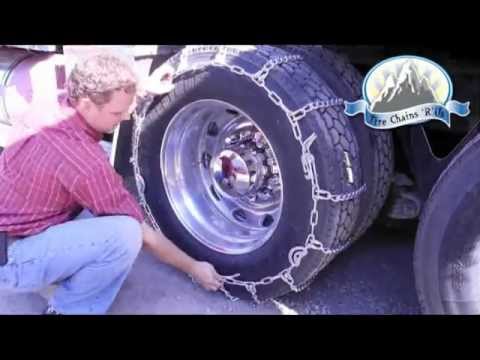
Climbing a slippery slope
In winter, before driving uphill, it is very important to assess the road conditions well so that the vehicle does not stop on a slope with the drive wheels spinning in place.
Snow chains must be put on the wheels before approaching the slope. Having put on the chains, it is necessary to check whether the wheel nuts are well tightened. nine0005
There are several ways to keep the drive wheels from spinning when climbing uphill:
If the road is sloping, always put on chains, especially on the wheel above, and do not forget to wear a bright vest. nine0005
ATTENTION! When stopped on a slippery road, the wheels are hot. Be aware that the vehicle may begin to slide even though the brakes are on!
Be aware that the vehicle may begin to slide even though the brakes are on!
By deliberately choosing the track, you can avoid the most slippery parts of the road lane.
When driving as fast as possible before a slope, less traction is required at the top of the slope and the accelerator pedal can be released slightly. Select a gear so that the revs are relatively high when going uphill, because if the wheels start to spin, you can release the accelerator a little and the car will start moving again before the revs drop to such a level that you have to lower gear. If the vehicle has a multi-axle axle, it is possible to achieve a higher axle load by using an axle lift. nine0005
By shifting to a lower gear (preferably 2nd) in time, you will not need to change gear when going uphill. If you choose the wrong gear, you may have to stop, and because of this, even bigger problems can arise. In vehicles with automatic transmission, it may be necessary in many cases, when it is slippery, to change to manual control of the transmission.